Researchers from the National Institute of Standards and Technology (NIST) were examining sugar-coated nanoparticles for use as a probable cancer therapy. They have apparently exposed that a subtle balancing act supposedly makes the particles more effectual.
In collaboration with colleagues at The Johns Hopkins University, Dartmouth College, the University of Manitoba and two biopharmaceutical companies, the NIST team has illustrated that the particles basically sugar-coated bits of iron oxide, about 100 nanometers wide could be powerful cancer killers as they cooperate with one another in ways that smaller nanoparticles apparently do not.
The communications may assist the bigger particles heat up better when they are put through an irregular magnetic field. Since this heat apparently kills the cancer cells, the team’s results may assist engineers in designing better particles and treatment process.
It is alleged that nanoparticles embrace the assurance of combating cancer without the harmful side effects of chemotherapy or radiation treatment. Microscopic balls of iron oxide may be covered with sugar molecules by making them predominantly striking to resource-hungry cancer cells. Once the particles are supposedly inserted, cancer cells could then consume them, and doctors may apparently be able to apply an alternating magnetic field that may be the reason for the iron oxide centers to heat, by destroying the cancer but leaving nearby tissue uninjured.
Micromod Partikeltechnologie and Aduro BioTech, two biotech companies developed particles that apparently demonstrated immense likelihood in treating cancers in mice. They requested NIST to assist them in finding out why it worked so well.
NIST materials scientist Cindi Dennis, commented, “But they sent us particles that were much larger than what the conventional wisdom says they should be. Larger particles are more strongly magnetic and tend to clump together, which makes them large enough to attract the body’s defense systems before they can reach a tumor. The companies’ nanoparticles, however, did not have this problem.â€
Neutron distribution investigation at the NIST Center for Neutron Research exposed that the particle’s larger iron oxide cores may attract one another, but that the sugar coating supposedly has fibers widening out. These fibers apparently shove against one another when apparently two particles get too close together, by making them spring apart and by preserving an antibody-defying detachment rather than clumping.
Furthermore, when the particles get close, the iron oxide centers all apparently spin together under the power of a magnetic field, both producing more heat and depositing this heat in the vicinity. All these features apparently assisted the nanoparticles to kill breast tumors in supposedly three out of four mice post one treatment with apparently no regrowth.

